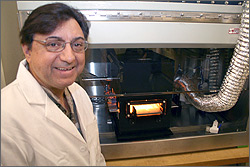NREL’s Optical Furnace Technology Sparks Industry Interest

NREL Principal Engineer Bhushan Sopori has fired up an optical furnace he developed to efficiently fabricate solar cells. Credit: Ray David, NREL
September 5, 2008
Applied Optical Systems, a startup company, has recognized the great potential of the National Renewable Energy Laboratory’s (NREL) advanced optical furnace technology for manufacturing thin-film silicon cells. “We’d like to develop thin-film silicon cells with higher efficiencies, up to 15 to 18 percent, and we believe this furnace will enable us to do so,” says A. Rangappan, founder and CEO of Applied Optical Systems.
Rangappan also says it will take only a few minutes for this optical furnace to process a thin-film solar cell, which reduces manufacturing costs. Overall, he estimates the company’s solar cell will cost around $.80 per watt.
For manufacturing these thin-film silicon cells, Applied Optical Systems and NREL have developed a partnership through a cooperative research and development agreement to construct an optical furnace system prototype. The U.S. Department of Energy is providing $500,000 from its Technology Commercialization Development Fund (TCDF) to develop the prototype design because of the technology’s significant market potential. The TCDF Program has provided the NREL Technology Transfer Office with a total of $4 million to expand such collaborative efforts between NREL researchers and companies.
Bhushan Sopori, a principal engineer at NREL, and his research team have advanced the technology to the point where it will benefit all solar cell manufacturers. “This advanced optical furnace is highly energy efficient, and it can be used to manufacture any type of solar cell,” he says.
Each type of solar cell or manufacturing process typically requires a different furnace configuration and temperature profile. With NREL’s new optical furnace system, a solar cell manufacturer can ask the computer for any temperature profile needed for processing a solar cell, and the same type of furnace is suitable for several solar cell fabrication process steps.
“In the future, solar cell manufacturers will only need this one optical furnace because it can be used for any process, including diffusion, metallization and oxidation,” Sopori says. “This helps reduce manufacturing costs.”
Meanwhile, another partnership using the optical furnace has evolved between NREL and SiXtron Advanced Materials, another startup. Together they’ll use the optical furnace to optimize the metallization process for novel antireflective solar cell coatings. The process is not only expected to yield higher efficiencies for silicon-based solar cells, but also lowers processing costs and eliminates safety concerns for manufacturers.
Most solar cell manufacturers currently use a plasma-enhanced chemical vapor deposition (PECVD) system with compressed and extremely pyrophoric silane gas (SiH4) for applying passivation antireflective coatings (ARC). If silane is exposed to air, the SiH4 will explode—a serious safety issue for high-volume manufacturers. SiXtron’s process uses a solid, silicon-based polymer that’s converted into noncompressed, nonexplosive gas, which then flows to a standard PECVD system.
“The solid source is so safe to handle that it can be shipped by FedEx,” says Zbigniew Barwicz, president and CEO of SiXtron.
Barwicz says manufacturers can use the same PECVD processing equipment for the SiXtron process that they already use for SiH4, a plug-and-play solution. For this novel passivation ARC process, NREL is helping to optimize the metallization parameters. NREL has developed a new technology called optical processing. One of the applications of this process is fire-through contact formation of silicon solar cells.
According to Sopori, NREL’s unique characterization tools—such as a reflectometer, electron microscopy capabilities and a high-speed optical scanning system called PVSCAN—will be very valuable in developing SiXtron’s material, so that it surpasses the properties of silicon nitride.






